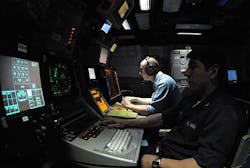SAIC and Vadum join DARPA EW initiative to counter programmable adaptive radar
ARLINGTON, Va., 13 March 2013. Two additional U.S. research organizations have been chosen to participate in a military electronic warfare (EW) project to find ways to detect and counter digitally programmable radar systems that have unknown behaviors and agile waveform characteristics.
Science Applications International Corp. (SAIC) in McLean, Va., and Vadum Inc. in Raleigh, N.C., are the latest contractors chosen for the Adaptive Radar Countermeasures (ARC) program of the U.S. Defense Advanced Research Projects Agency (DARPA) in Arlington, Va.
The DARPA ARC program seeks to develop EW capability to counter hostile adaptive radar systems based on their over-the-air signals. SAIC won a $31.5 million contract last Friday, and Vadum won a $4.1 million contract on 5 March.
SAIC and Vadum join Helios Remote Sensing Systems Inc. in Rome, N.Y., and Michigan Tech Research Institute (MTRI) in Ann Arbor, Mich., on the ARC program to counter enemy radar that senses its environment and automatically adapts to attempts to jam it. Helios won a $2.9 million ARC contract on 13 Feb., and MTRI won an $8 million contract on 20 Feb.
Today's airborne EW systems are proficient at identifying analog radar systems that operate on fixed frequencies. Once they identify a hostile radar system, EW aircraft can apply a preprogrammed countermeasure technique.
Yet the job of identifying modern digitally programmable radar variants using agile waveforms is becoming more difficult. EW experts at Helios and MTRI will work to enable systems to generate effective countermeasures automatically against new, unknown, or ambiguous radar signals in near real-time.
Radar and EW experts at the four companies will develop new processing techniques and algorithms that characterize enemy radar systems, jam them electronically, and assess the effectiveness of the applied countermeasures.
The goal of the DARPA ARC program is to develop ways to counter adaptive radar threats quickly based on over-the-air observable signals.
Threats of particular interest include ground-to-air and air-to-air phased array radars capable of performing several different functions, such as surveillance, cued target acquisition, tracking, non-cooperative target identification, and missile tracking. These kinds of radar systems are agile in beam steering, waveform, coding, and pulse repetition interval.
Key challenges to SAIC, Vadum, Helios, and MTRI researchers are how to isolate signals clearly amid hostile, friendly, and neutral signals; figuring out the threat the signal poses; and jamming the signal.
Today's airborne electronic warfare (EW) systems match enemy radar signals and determine appropriate countermeasures based a list of known threats, but are limited when enemy signals are ambiguous or not on the list.
Modern enemy radar systems, however, are becoming digitally programmable with unknown behaviors and agile waveform, so identifying and jamming them is becoming increasingly difficult.
Things will get worse in the future as radars develop the ability to sense their environment and adapt their transmission characteristics and pulse processing algorithms to defeat attempts to jam them.
The objective of the four companies involved in the ARC program is to enable EW systems to generate effective countermeasures automatically against new, unknown, or ambiguous radar signals as they are encountered.
The organizations will try to develop new processing techniques and algorithms to counter adaptive radar threats through real-time analysis of the threat's over-the-air observable properties and behaviors.
The program will develop a closed-loop system with signal analysis and characterization, countermeasure synthesis, and countermeasure effectiveness assessment. The system not only will be able to learn automatically to counter new radar threats, but also will enable human operators to command and receive feedback from the system.
DARPA officials say that software algorithms the four companies develop under the ARC program most likely will be used in existing or planned EW systems.
The ARC system should be able to isolate agile unknown radar threats in dense, complex electromagnetic environments with friendly, hostile and neutral RF emitters; counter these new radar threats; provide real-time feedback on countermeasure effectiveness; counter several threats at once; support single-platform or distributed, multi-platform operations; support autonomous and human-in-the-loop operation; and use a standards-based, modular, open and extensible software architecture. The system also should be able to store and download new knowledge and countermeasures for post-mission analysis.
The ARC program is a five-year effort. The first 30 months focuses on algorithm development and component level testing; the second 18 months focuses on systems development; and the remaining two years is for building a real-time ARC prototype.
For more information contact SAIC online at www.saic.com, Vadum at www.vaduminc.com, Helios Remote Sensing Systems at www.heliossensors.com, MTRI at www.mtri.org, or DARPA at www.darpa.mil.
